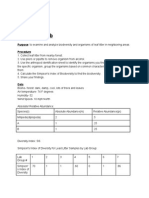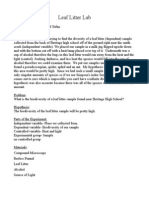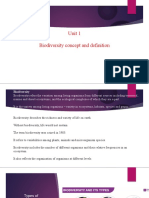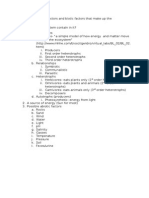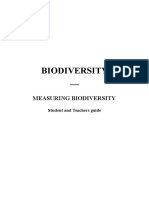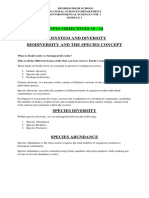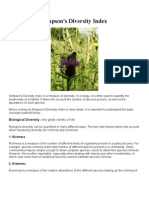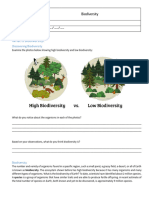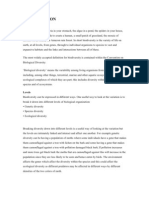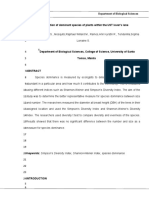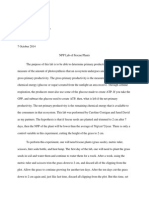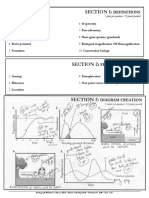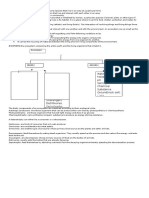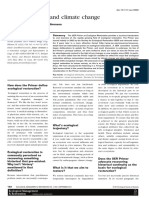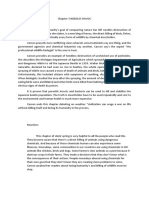Leaf Litter Lab
Leaf Litter Lab
Uploaded by
awswenson13Copyright:
Available Formats
Leaf Litter Lab
Leaf Litter Lab
Uploaded by
awswenson13Original Description:
Copyright
Available Formats
Share this document
Did you find this document useful?
Is this content inappropriate?
Copyright:
Available Formats
Leaf Litter Lab
Leaf Litter Lab
Uploaded by
awswenson13Copyright:
Available Formats
Anna Swenson
Mrs. Norris
AP Environmental Science
3 October 2014
Leaf Litter Lab: Preformed by Anna Swenson, Caroline Corrigan and Jared David
The biodiversity of a habitat shows how healthy that area is. How do you calculate the
biodiversity of a sample? The biodiversity depends on the richness (number of species per
sample) and the evenness (measure of the amount of each species). If a habitats richness and
evenness are increasing then the biodiversity will also increase. To calculate the diversity of an
area one must use the Simpsons index formula to determine the probability that two individuals
randomly selected from a sample will belong to the same species. After the value of the
biodiversity is calculated, the closer the number is to zero the higher the biodiversity. The
independent variable was the sample taken in the trails of Heritage high school and the
dependent variable is the amount of biodiversity calculated after performing the lab. If we take
leaf samples from the trails behind Heritage High school, then there will be a high biodiversity
between .3-0 because the ecosystem is healthy and rich.
To perform this experiment the supplies needed are, a compound microscope, Berlese
funnel, leaf little, alcohol and a source of light. First collect a sample of leaf litter from top layer
down to the soil. Secondly, examine the sample and classify what you see the layer is composed
of. Thirdly, place the sample into the Berlese funnel under the light source and place a small
beaker of alcohol under the funnel. The macro-invertebrates will deter away from the light
source and fall through the bottom of the funnel into the beaker of alcohol. Then, after a day,
collect beaker and examine organisms you have collected under the microscopes. Record the
data of the different species and uses Simpsons index to calculated the biodiversity.
D=
()()()
()
D=.1
Species Name Quantity
Japygid 1
Psocid 1
Centipede 1
Isopod 1
Millipede 2
Ant 3
Spider 3
The data above shows the forested area behind Heritage High School is very diverse with
a Simpsons biodiversity of a .1. Through the leaf litter sample we found one of four of the
1 1 1 1
2
3 3
0
0.5
1
1.5
2
2.5
3
3.5
Japygid Psocid Centipede Isopod Millipede Ant Spider
A
m
o
u
n
t
s
f
o
u
n
d
Organisms
Biodiversity
species creating an increase in the evenness, contributing to the high biodiversity in the area.
Also having both the same number of spiders and ants (3) added to the increase in the
biodiversity of the sample. When pouring the alcohol solution into the petri dish, it is hard to see
the organisms in the solution. But, when the petri dish is put under the microscope many
organisms become clear. The bugs crawled to the bottom of the funnel to simulate the moist
ground and the diverting away from the sun light. This process led to the macro-invertebrates
falling into the alcohol solution. The biodiversity of the leaf litter of Heritage High school was
very high being a .1. This area has a high biodiversity because it is a primary succession and is
healthy.
Calculating biodiversity is important because it can be used in comparison to show
effects overtime in a habitat. For example, in the rainforests calculating biodiversity years ago till
now would show the negative ways humans have impacted the ecosystem by cutting down trees
and decreasing the biodiversity of that area. An environmental scientist would have to sample the
same area multiple times then spread over the land comparing the samples from around the
woods. Many factors would contribute to the biodiversity being high or lower even 15 yards
away, such as closer to a water source or river. Biodiversity measures the health of an ecosystem.
Works Cited
"Lab Report Rubric." Wake County, n.d. Web.
<https%3A%2F%2Fdrive.google.com%2Ffile%2Fd%2F0B1zpG8NfJrpVYlF2a0tlcl9pUUk%2Fedit>.
You might also like
- Lab ReportDocument6 pagesLab ReportJenniferNo ratings yet
- Hannah Midles Leaf Litter LabDocument7 pagesHannah Midles Leaf Litter Labapi-263046827No ratings yet
- Leaf Litter Lab ReportDocument6 pagesLeaf Litter Lab Reportapi-2676017820% (1)
- Leaf Litter LabDocument4 pagesLeaf Litter Labapi-293913139No ratings yet
- Aquatic Ecosystems: Yates Mill PondDocument7 pagesAquatic Ecosystems: Yates Mill PondVellie JohnsonNo ratings yet
- Biodiversity: Biodiversity and Field Ecology - March 20, 2014Document8 pagesBiodiversity: Biodiversity and Field Ecology - March 20, 2014Reshma SomanNo ratings yet
- Leaf Litter LabDocument6 pagesLeaf Litter Labapi-237363604No ratings yet
- The Diversity of Soil Invertebrates Found in Your Backyard: AbstractDocument6 pagesThe Diversity of Soil Invertebrates Found in Your Backyard: AbstractBigBoom2No ratings yet
- Ecology and The EnvironmentDocument70 pagesEcology and The EnvironmentSein Hla KyawNo ratings yet
- Unit 1Document49 pagesUnit 1Kanthimathi MuthusamyNo ratings yet
- What Is Ecology?: Key PointsDocument7 pagesWhat Is Ecology?: Key PointsMaryam AliNo ratings yet
- HellDocument3 pagesHellapi-278312041No ratings yet
- A2as Biol Revised Support 5925Document9 pagesA2as Biol Revised Support 5925GilbertNo ratings yet
- NSW Biology 01Document75 pagesNSW Biology 01maria paulNo ratings yet
- 01 Chapter Ecology Mod 8 - 07Document60 pages01 Chapter Ecology Mod 8 - 07George ChandlerNo ratings yet
- ENVI NOTES Module 1 Objectives 10-14Document18 pagesENVI NOTES Module 1 Objectives 10-14Nick MillerNo ratings yet
- Simpsons Diversity IndexDocument11 pagesSimpsons Diversity IndexGajen Demonz100% (1)
- What is population density and name the symboy that stands for populationDocument11 pagesWhat is population density and name the symboy that stands for populationAditya PattanaikNo ratings yet
- Bio LabDocument3 pagesBio Lab74481770jNo ratings yet
- Biodiveristy of Leaf LitterDocument9 pagesBiodiveristy of Leaf LitterChris V-PandaNo ratings yet
- Science Work (Almost Late)Document34 pagesScience Work (Almost Late)PedroNo ratings yet
- Invertebrate DiversityDocument9 pagesInvertebrate DiversityAsma AyyadNo ratings yet
- BiodiversityDocument16 pagesBiodiversityAyub100% (1)
- BiodiversityDocument25 pagesBiodiversityOrane CassanovaNo ratings yet
- Practical 2 DecomposesDocument8 pagesPractical 2 DecomposesYu QingNo ratings yet
- Organisms and Their Environment Lecture 1Document46 pagesOrganisms and Their Environment Lecture 1amanirameez84No ratings yet
- Ecology Review KeyDocument5 pagesEcology Review KeyYonasNo ratings yet
- Biodiversity Class NotesDocument29 pagesBiodiversity Class NotesmurugeswariguruvaiahNo ratings yet
- What Is An EcosystemDocument2 pagesWhat Is An EcosystemThe IdiotNo ratings yet
- AP Environmental Science Flashcards, Fourth Edition: Up-to-Date ReviewFrom EverandAP Environmental Science Flashcards, Fourth Edition: Up-to-Date ReviewNo ratings yet
- Key Points Ecology Is The Study of How OrganismsDocument4 pagesKey Points Ecology Is The Study of How OrganismsMARJ EGIPTONo ratings yet
- 5 - Biodiversity Material ENGDocument5 pages5 - Biodiversity Material ENGXimena Lucia Grandez BreñaNo ratings yet
- Quarter 4 BiodiversityDocument88 pagesQuarter 4 BiodiversityRon SantiagoNo ratings yet
- Scope of EcologyDocument7 pagesScope of Ecologyckyalo0123No ratings yet
- Healthy or Not?Document10 pagesHealthy or Not?Codruta SandiNo ratings yet
- A Local EcosystemDocument5 pagesA Local EcosystemVivian XieNo ratings yet
- 2010 Rubenstein ASB Vol42Document28 pages2010 Rubenstein ASB Vol42merryrosegrutasNo ratings yet
- Biology Lab Report 10 (Ecology)Document22 pagesBiology Lab Report 10 (Ecology)Muhamad Aleiff Bin Tajuddin100% (1)
- Living Things and Their EnvironmentDocument3 pagesLiving Things and Their EnvironmentVergzMonch EspielNo ratings yet
- Ms Staar Review Reportingcategory 4Document57 pagesMs Staar Review Reportingcategory 4api-234480965100% (1)
- GARINGALAO, Module 4&5 Sci102Document24 pagesGARINGALAO, Module 4&5 Sci102Shane GempasaoNo ratings yet
- Newtsletter 46 2010Document10 pagesNewtsletter 46 2010Sussex Amphibian & Reptile GroupNo ratings yet
- Prac 4 BiodaivesitiDocument17 pagesPrac 4 BiodaivesitimdrozifiakNo ratings yet
- BIODIVERSITYDocument20 pagesBIODIVERSITYMarie Cris SorianoNo ratings yet
- Ecology Revision - Previous TopicsDocument30 pagesEcology Revision - Previous Topicsxofah81094No ratings yet
- Chapter 4 Biodiversity ScriptDocument7 pagesChapter 4 Biodiversity ScriptApodedNo ratings yet
- Comparative Study of Lizards of Mt. Makiling Secondary Old Growth Forest and Mahogany PlantationDocument52 pagesComparative Study of Lizards of Mt. Makiling Secondary Old Growth Forest and Mahogany Plantationseph03No ratings yet
- Lab Activity 1 - Organisms and Their EnvironmentDocument7 pagesLab Activity 1 - Organisms and Their EnvironmentMariah Ray RintNo ratings yet
- Unit 4Document44 pagesUnit 4Cindy AcostaNo ratings yet
- 5 BiosferDocument100 pages5 Biosferrana zenissaNo ratings yet
- Science 9 Week 5 Quarter 1Document24 pagesScience 9 Week 5 Quarter 1L.J. Santos100% (2)
- Chap 12 - EcosystemsDocument19 pagesChap 12 - Ecosystemssuhanachavan25No ratings yet
- What Is BiodiversityDocument13 pagesWhat Is BiodiversitySachin NarangNo ratings yet
- EcologyDocument45 pagesEcology2028murray.jujuNo ratings yet
- Department of Biological Sciences UST College of ScienceDocument12 pagesDepartment of Biological Sciences UST College of ScienceSophia Lorraine TendenillaNo ratings yet
- Ecosystem SummaryDocument98 pagesEcosystem Summarylamug.406591150032No ratings yet
- Module 7Document27 pagesModule 7bhrayancacheroNo ratings yet
- Our Environment A Our ConcernDocument9 pagesOur Environment A Our ConcernIpshita PathakNo ratings yet
- Biodiversity: Explore the Diversity of Life on Earth with Environmental Science Activities for KidsFrom EverandBiodiversity: Explore the Diversity of Life on Earth with Environmental Science Activities for KidsNo ratings yet
- Acid Rain Lab APESDocument4 pagesAcid Rain Lab APESawswenson13No ratings yet
- APES Erosion LabDocument3 pagesAPES Erosion Labawswenson13No ratings yet
- Energy Audit LabDocument6 pagesEnergy Audit Labawswenson13No ratings yet
- NPP Lab of Fescue PlantsDocument3 pagesNPP Lab of Fescue Plantsawswenson13100% (1)
- Something Fishy LabDocument3 pagesSomething Fishy Labawswenson13No ratings yet
- Borneanus (Roos Et Al. 2014 - Asian PrimatesDocument5 pagesBorneanus (Roos Et Al. 2014 - Asian PrimatesIda Bagus Ketut WedastraNo ratings yet
- Biodiversity and Climate Change - Acheiving Targets 2020Document160 pagesBiodiversity and Climate Change - Acheiving Targets 2020mkvmemberNo ratings yet
- J. Doyne Farmer - Maarten P. Scholl - Anisoara Callinescu - How Market Ecology Explains Market MalfunctionDocument9 pagesJ. Doyne Farmer - Maarten P. Scholl - Anisoara Callinescu - How Market Ecology Explains Market MalfunctionRobertoNo ratings yet
- Question Paper With Solution July 2023 (Eve)Document9 pagesQuestion Paper With Solution July 2023 (Eve)pratima1514No ratings yet
- Reading-10-12 8 2024Document10 pagesReading-10-12 8 2024Nguyễn Thảo NgânNo ratings yet
- 9903 23934 1 PBDocument8 pages9903 23934 1 PBHardiyanto HardiyantoNo ratings yet
- Multiple Choice QuestionsDocument3 pagesMultiple Choice Questionsfk4963075No ratings yet
- Voland,, 1998 Ecología de La Reproducción HumanaDocument30 pagesVoland,, 1998 Ecología de La Reproducción HumanaAylin Lidsay Feria GNo ratings yet
- Response of Wheat To Irrigation and Hydrogel With Nutrient ManagementDocument6 pagesResponse of Wheat To Irrigation and Hydrogel With Nutrient ManagementTJPRC PublicationsNo ratings yet
- Science 9 Week 5 Quarter 1Document24 pagesScience 9 Week 5 Quarter 1L.J. Santos100% (2)
- Answer Key - B Division - Ecology - KC Regionals 2018Document2 pagesAnswer Key - B Division - Ecology - KC Regionals 2018Veena AgaramNo ratings yet
- An Analysis of Ecuadors Rose Industry and Its Impact On Soil AnDocument1 pageAn Analysis of Ecuadors Rose Industry and Its Impact On Soil AnAryanNo ratings yet
- Characteristics of Ecological SystemDocument1 pageCharacteristics of Ecological SystemJudyAnIntongQuiroyNo ratings yet
- Dadasaheb Mokashi College of Agriculture: WelcomeDocument20 pagesDadasaheb Mokashi College of Agriculture: WelcomeRupchand AwaleNo ratings yet
- Unit 9 - Planet Issues - PresentationDocument21 pagesUnit 9 - Planet Issues - PresentationOriana De NóbregaNo ratings yet
- Clewell-Aronson 0020 EMR 0020 Primer Oct 0020 2013Document5 pagesClewell-Aronson 0020 EMR 0020 Primer Oct 0020 2013Chaca ChadijahNo ratings yet
- Why Is Biodiversity ImportantDocument28 pagesWhy Is Biodiversity ImportantAarthi PadmanabhanNo ratings yet
- 4 Sustainable Planning Concepts at The Beginning of 21stDocument48 pages4 Sustainable Planning Concepts at The Beginning of 21stNeha SardaNo ratings yet
- Historical Ecology: Past, Present and Future: Biological Reviews August 2015Document19 pagesHistorical Ecology: Past, Present and Future: Biological Reviews August 2015Sakshi SahuNo ratings yet
- Environmental Microbiology and BiotechnologyDocument20 pagesEnvironmental Microbiology and BiotechnologyRuben MarquezNo ratings yet
- Rajasthan GreenDocument15 pagesRajasthan GreenRakhi LakhwaniNo ratings yet
- Annals NY Academy of Science - 2020 - Lloyd - Environmental Catastrophes Climate Change and AttributionDocument20 pagesAnnals NY Academy of Science - 2020 - Lloyd - Environmental Catastrophes Climate Change and AttributionPasajera En TranceNo ratings yet
- Rainforest Vocabulary PDFDocument5 pagesRainforest Vocabulary PDFBernard QuiboyNo ratings yet
- CanihuaDocument8 pagesCanihuaEdwin SauñeNo ratings yet
- BIODIVERSITY CONSERVATION AssignmentDocument25 pagesBIODIVERSITY CONSERVATION AssignmentTasnuva RahmanNo ratings yet
- B. Sc. Part I Zoology DSC NEP 2.0Document22 pagesB. Sc. Part I Zoology DSC NEP 2.0Mahesh MutnaleNo ratings yet
- MAKALAH Psikologi PendDocument8 pagesMAKALAH Psikologi PendFirdaus AhmadNo ratings yet
- Ecology and Sustainable Development in Global Business: Mcgraw-Hill/IrwinDocument21 pagesEcology and Sustainable Development in Global Business: Mcgraw-Hill/IrwinMiu Miu LeeNo ratings yet
- NT Biology Answers Chapter 18Document4 pagesNT Biology Answers Chapter 18ASADNo ratings yet
- Chapter 7 NEEDLES HAVOCDocument4 pagesChapter 7 NEEDLES HAVOCRhea Lyn AquinoNo ratings yet



